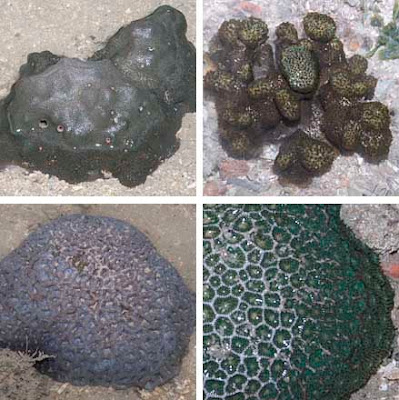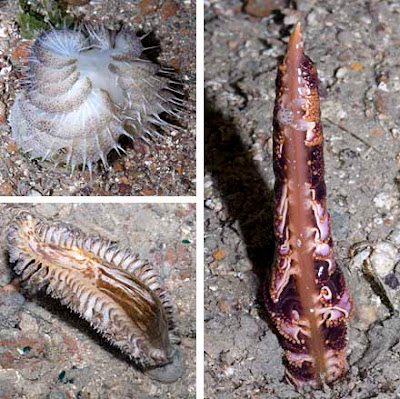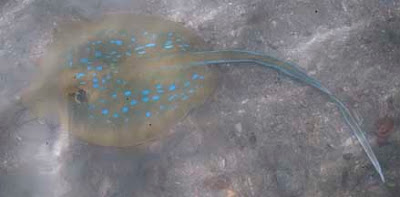I saw these delightful creatures during our annual visit to Beting Bronok, a submerged reef on our Northern shore
Here's another pair which don't seem to be too interested in one another ... yet? These pretty Cuthona sibogae are found in the orange fern-like hydroids (Sertularella sp.).
It was a relief to see that there are still clumps of many different kinds of colourful animals dotting the shore. During our trip last year, the shore seemed to suffer badly from coral bleaching.
Here's a selection of the colourful clusters of different kinds of animals. Sponges, corals, sea urchins, sea cucumbers and other marine creatures all crammed together. It's hard to look at everything during the short low tide window.
A wide variety of echinoderms can usually be found here. I saw six large Knobbly sea stars (Protoreaster nodosus) today. They were clustered together.
There were many Biscuit sea stars (Gonodiscaster scaber) large and small. I saw one Cake sea star (Anthenea aspera), one Painted sand star (Astropecten sp.) and one Red scaly sea star (Nepanthia sp.). Marcus also saw the Spiny sea star (Gymnanthenea laevis).
I saw several Thorny sea urchin (Prionodidaris sp.), some with slender spines, others with thicker spines. And I saw one one White sea urchin (Salmacis sp.) and one Black sea urchin (Temnopleurus sp.).
I also saw a wide variety of sea cucumbers: Orange sea cucumbers, Thorny sea cucumbers (Colochirus quadrangularis), Ball sea cucumber (Phyllophorus sp.), Purple sea cucumber.
I also saw one Garlic bread sea cucumber (Holothuria scabra).
Alas, none of us saw any feather stars (Class Crinoidea), which used to be common here.
There are some large hard corals here and they seemed fine. None of those I saw were bleaching. This is a relief as we saw signs of massive bleaching on our trip to Beting Bronok in Jun 2010.
Most of the hard corals I saw were Pore corals (Porites sp.). I also saw some Favid coral (Family Faviidae).
There were many Ball flowery soft corals on the shore. Some of the colonies were quite large. Last year, we saw few of these soft corals.
Some of the ball soft corals had a pair of white snapping shrimps. I looked but couldn't find any False cowrie snails, which are sometimes seen in these soft corals.
However, I did find False cowrie snails (Family Ovulidae) in the single Pink flowery soft corals (Family Nephtheidae) that I saw there. These snails are very well camouflaged in their host.
It was nice to see a Haekel's anemone (Actinostephanus haeckeli). Is it the same one I saw many years ago?
I saw many Haddon's carpet anemones (Stichodactyla haddoni) and none were bleaching. Many had the small anemone shrimps in them. But I didn't see any of the larger Five-spot anemone shrimps (Periclimenes brevicarpalis) in these anemones.
Other anemones were also seen. There were many Swimming anemones (Boloceroides mcmurrichi) large and small. I saw one Mangrove anemone and two Ball tip anemones. Chay Hoon also saw a Glass anemone (Dofleinia sp.).
I only saw one sea fans (Order Gorgonacea). When I got home I realised it seemed to have a tiny red spindle cowrie. Also some hermit crabs clinging to it.
I saw many flowery sea pens (Family Veretillidae) in different colours.
I also saw some of the other kinds of sea pens including the Spiky sea pen (Scytalium sp.), Common sea pen (Pteroides sp.) and Slender sea pen (Virgularia sp.).
A pair of tiny Painted porcelain crabs (Porcellanella picta) were seen in some of the sea pens.
There were also many clumps of these stinging hydroids which pack a powerful punch. We were careful not to touch them.
The dominant cnidarian on Beting Bronok remain zoanthids, mostly Button zoanthids (Zoanthus sp.). These animals carpet vast stretches of the shore making it impossible to walk without stepping on them.
The first thing we saw when we landed was a medium sized Bailer volutes (Melo melo)! Hurray. It was producing a lot of slime., Did it just eat something? About to lay eggs? Later on I saw another one. But I didn't see the large one that I saw on our trip last year.
I saw one large octopus. The rest of the team also spotted these animals elsewhere.
I also saw one cuttlefish.
I saw many Onyx cowries (Cypraea onyx). Sadly, I didn't take a closer look at all of them. Mei Lin and Kok Sheng did and discovered that some of them were another kind of snail!
I also saw the Calf moon snail (Natica vitellus).
I didn't many nudibranchs. Just the Discodoris boholiensis, and by accident (i.e., only saw when processing photos at home), this tiny slug with 'pink hairs', and also a tiny Strawberry slug (Costasiella sp.). But Chay Hoon and the rest of the team spotted lots and lots of nudis and slugs.
Large Fan shell clams (Family Pinnidae) are still seen today, often festooned with living encrusting marine life.
There were lots of Swimming crab (Family Portunidae) of all kinds. Also some Sponge crabs (Family Dromiidae) and Velcro crabs (Camposcia retusa). I also saw many shrimps of all kinds and sizes including some medium sized Penaeid shrimps (Family Penaeidae).
There was a Coastal horseshoe crab (Tachypleus gigas) half buried in the sand, probably still alive. I also saw two dead ones. Oh dear.
The tide wasn't very low today and the water in the 'stingray lagoon' was murky. So we stayed away from it. Which is a good thing, because even in the clearish portion, I saw a Blue-spotted fantail ray (Taeniura lymma)!
There are also many different kinds of fishes on the shores. Lots of little gobies (Family Gobiidae), many small rabbitfishes (Family Siganidae), filefishes (Family Monacanthidae) and toadfishes. Unlike on our trip last year, only one Brown-spotted moray eel (Gymnothorax reevesii) was seen today.
There are all kinds of colourful sponges on this shore. Some of the sponges were quite large. Most of them seemed healthy and unbleached.
I saw some interesting worms, including one Blue-lined flatworm (Pseudoceros sp.) and several large Black spotted flatworms (Acanthozoon sp.). Also several different kinds of fanworms (Family Sabellidae).
There were many different kinds of seaweeds on the shore, with large patches of green seaweeds. I didn't get a chance to see all of the shore so missed checking up on whether the seagrasses are still on this shore.
It was barely sunrise but we had to leave as the tide was turning. The jet lag from these predawn trips is starting to hit me, but it's worth it to have a glimpse of this magical shore.
Thanks to Chay Hoon for organising the trip! More photos and stories of others who came for this trip below.
It was a relief to see that the shore is no longer suffering from bleaching! And Beting Bronok remains full of fascinating creatures. But to me, it remains a shadow of the way it was before reclamation started nearby. It has since also been affected by the flooding that led to mass deaths at Chek Jawa in 2007, and the coral bleaching in 2010. Here's some old photos of marine life at Beting Bronok. We can only hope for the best for this wonderful reef on our Northern shore.
Posts by others who came for this trip
- James on facebook with lots of nudis! And on his blog with MORE photos.
- Russel on facebook, his first trip to Beting Bronok with lots of colourful marine life.
- Chay Hoon with nudibranchs galore and more!
- Kok Sheng with more slugs, stars and a curious non-cowrie.
- Mei Lin has a look at how marine creatures deal with their 'housing issues'.




































